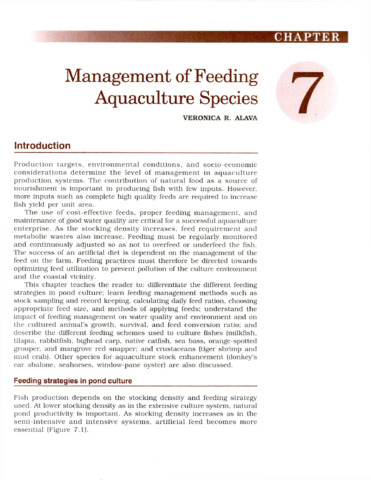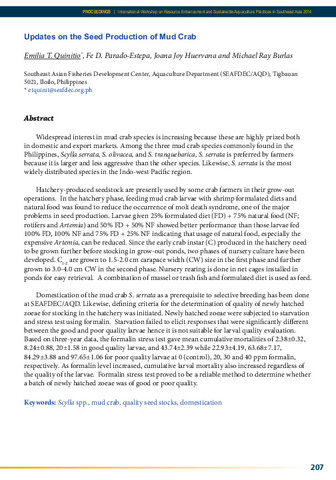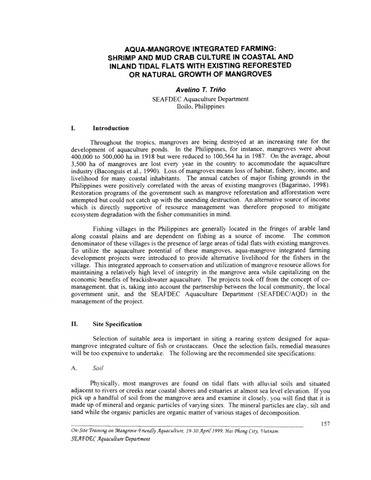| dc.contributor.author | Alava, Veronica R. | |
| dc.contributor.author | Sumile, Jony D. | |
| dc.contributor.author | Parado-Estepa, Fe D. | |
| dc.contributor.editor | Quinitio, Emilia T. | |
| dc.contributor.editor | Parado-Estepa, Fe Dolores | |
| dc.contributor.editor | Coloso, Relicardo M. | |
| dc.date.accessioned | 2017-08-25T09:13:41Z | |
| dc.date.accessioned | 2017-08-25T16:36:53Z | |
| dc.date.available | 2017-08-25T09:13:41Z | |
| dc.date.available | 2017-08-25T16:36:53Z | |
| dc.date.issued | 2017 | |
| dc.identifier.citation | Alava, V. R., Sumile, J. D., & Parado-Estepa, F. D. (2017). Nursery culture of mud crab, Scylla serrata, using different ratios of natural food to formulated feed. In E. T. Quinitio, F. D. Parado-Estepa, & R. M. Coloso (Eds.), Philippines : In the forefront of the mud crab industry development : proceedings of the 1st National Mud Crab Congress, 16-18 November 2015, Iloilo City, Philippines (pp. 52-58). Tigbauan, Iloilo, Philippines: Aquaculture Department, Southeast Asian Fisheries Development Center. | en |
| dc.identifier.isbn | 9789719931072 | |
| dc.identifier.uri | http://hdl.handle.net/10862/3198 | |
| dc.description.abstract | The effect of feeding different ratios of natural food to formulated feed on the production and profitability of Phases 1 and 2 of nursery culture (3 weeks per phase) of hatchery-produced crab Scylla serrata was investigated. The feeds consisted of: mussel meat (M) alone, formulated diet (FD) alone, and their combination at M:FD ratios of 5 : 95, 10 : 90, 15 : 85, 20 : 80, 25 : 75 and 30 : 70. The crabs were stocked randomly in 12-m2 net cages installed in the nursery pond at stocking density of 50 m-2 for Phase 1 and 10 m-2 for Phase 2. Crabs were fed three times daily at 0830, 1300 and 1630 h. Results showed that in both phases, the survival rate, body weight, carapace width, and feed conversion ratio of crabs fed M, FD, and combination at different ratios were not significantly different (p>0.05). Profitability was better in 15 M:85 FD or 20 M :80 FD (Phase 1) and 30 M:70 FD ratio (Phase 2). The use of complete formulated diet as feed for crabs reduced the reliance on wet natural food. | en |
| dc.language.iso | en | en |
| dc.publisher | Aquaculture Department, Southeast Asian Fisheries Development Center | en |
| dc.subject | Scylla serrata | |
| dc.subject | Philippines | en |
| dc.title | Nursery culture of mud crab, Scylla serrata, using different ratios of natural food to formulated feed | en |
| dc.type | Conference paper | en |
| dc.citation.spage | 52 | |
| dc.citation.epage | 58 | |
| dc.subject.asfa | aquaculture | en |
| dc.subject.asfa | aquaculture economics | en |
| dc.subject.asfa | artificial feeding | en |
| dc.subject.asfa | body weight | en |
| dc.subject.asfa | brackishwater aquaculture | en |
| dc.subject.asfa | cage culture | en |
| dc.subject.asfa | Diets | en |
| dc.subject.asfa | feeds | en |
| dc.subject.asfa | feed efficiency | en |
| dc.subject.asfa | feeding | en |
| dc.subject.asfa | feeding experiments | en |
| dc.subject.asfa | live feeds | en |
| dc.subject.asfa | stocking density | en |
| dc.subject.asfa | survival | en |
| dc.citation.conferenceTitle | Philippines : In the forefront of the mud crab industry development : proceedings of the 1st National Mud Crab Congress, 16-18 November 2015, Iloilo City, Philippines | en |
| dc.subject.scientificName | Scylla serrata | |



